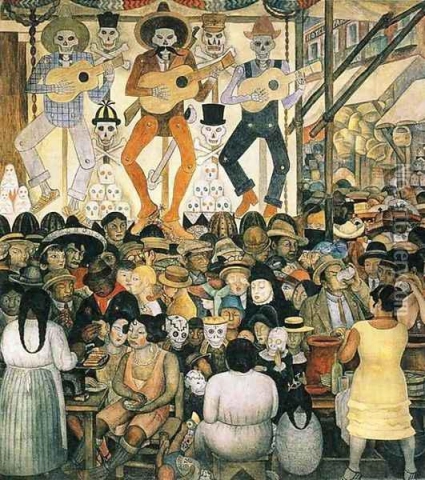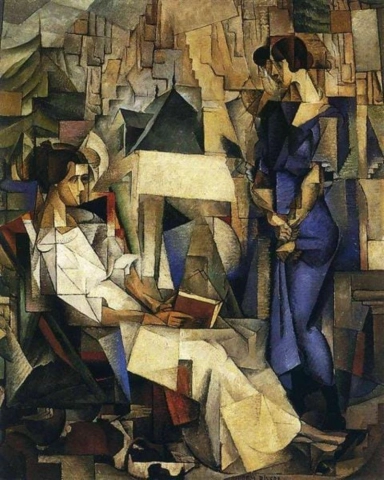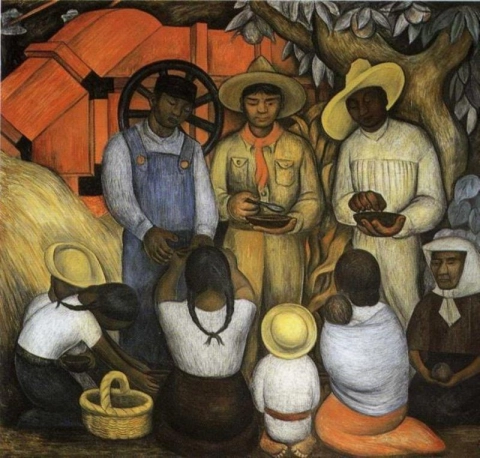

Hand painted reproductions of Diego Rivera
Diego Rivera: A Master of Muralism and Mexican Art
Diego Rivera (1886–1957) was a renowned Mexican painter and muralist, considered one of the most influential figures in the history of art. Known for his large-scale murals, Rivera's work sought to communicate social and political messages, reflecting his commitment to the Mexican Revolution and the struggles of the working class. His murals, which adorned public buildings in Mexico and the United States, became powerful symbols of Mexican identity and culture, combining traditional Mexican elements with European artistic influences.
Early Life and Education
Diego Rivera was born in Guanajuato, Mexico, in 1886, into a middle-class family with a strong interest in the arts. From a young age, Rivera showed a talent for drawing, and his parents encouraged his artistic development. At the age of ten, he entered the Academy of San Carlos in Mexico City, where he received formal training in painting and drawing.
Rivera’s education continued in Europe, where he studied at the renowned San Fernando Royal Academy of Fine Arts in Madrid and later at the prestigious Academy of San Carlos in Mexico City. During his time in Europe, Rivera was exposed to the art of the Renaissance, particularly the works of Michelangelo and other Italian masters, which had a lasting impact on his style. Rivera also spent time in Paris, where he encountered the works of modern artists, including the Cubists, which would significantly influence his later work.
Artistic Development and Style
Rivera’s early work was influenced by European modernist movements, particularly Cubism. However, his true artistic breakthrough came when he turned to muralism, a form of public art that would become his signature style. His murals often depicted scenes from Mexican history, including the struggles of the indigenous people and the working class. Through these large-scale works, Rivera sought to tell the story of Mexico’s revolution and its fight for social justice.
One of Rivera’s greatest achievements was his ability to blend elements of Mexican folk art with European techniques, creating a unique visual language that was both modern and deeply rooted in Mexican tradition. His murals featured bold, vibrant colors and intricate compositions, combining figures, symbols, and historical narratives in a dynamic and engaging way. Rivera’s work often celebrated the labor and dignity of the working class, emphasizing the importance of social change and revolution.
While Rivera was initially drawn to the Cubist movement, his murals and paintings evolved to include a more representational style, emphasizing human figures and their connection to the environment. His mastery of space, form, and color allowed him to create murals that were both visually striking and emotionally compelling.
Themes and Significance
Diego Rivera’s art was deeply connected to the social and political movements of his time. A Marxist, Rivera used his art as a tool for social change, advocating for the rights of the working class and indigenous peoples. His murals often depicted the exploitation of labor and the need for social and political revolution, making his work not only a visual feast but also a powerful commentary on the human condition.
Rivera’s murals celebrated Mexican culture, history, and identity, highlighting the contributions of indigenous peoples and their role in shaping the country’s history. He frequently portrayed scenes of labor, revolution, and social struggles, emphasizing the dignity of the working class and the importance of collective action. His art sought to communicate the ideals of the Mexican Revolution and promote a vision of social equality and justice.
Rivera’s murals were also influenced by his strong belief in the power of public art. He believed that art should be accessible to the people and that it could serve as a catalyst for social change. His murals were often placed in public buildings, where they could be viewed by a wide audience, making his message both immediate and far-reaching.
Achievements and Influence
Diego Rivera’s artistic career was marked by numerous significant achievements. His murals can be found in public buildings throughout Mexico and the United States, including the National Preparatory School in Mexico City and the Detroit Institute of Arts. His murals were revolutionary not only in their artistic style but also in their subject matter, which often dealt with political themes and social issues.
Rivera's influence extended beyond the walls of his murals. His work had a profound impact on the development of Mexican art, particularly in the context of the Mexican Muralism movement. Alongside fellow artists José Clemente Orozco and David Alfaro Siqueiros, Rivera was part of a group of artists who sought to create a new, national identity for Mexico through public art. Rivera’s murals helped to solidify the Mexican Muralism movement as one of the most important artistic movements of the 20th century.
His influence also extended internationally. Rivera’s murals in the United States, particularly his work at the Rockefeller Center in New York, brought him global recognition. Despite controversies, such as the destruction of his mural at Rockefeller Center due to its inclusion of an image of Lenin, Rivera’s international reputation grew, and he became one of the most recognized artists of his time.
Legacy
Diego Rivera's legacy as a muralist and painter is one of social consciousness, political activism, and artistic innovation. His murals continue to be celebrated for their boldness, their intricate storytelling, and their ability to communicate complex social and political messages through art. Rivera’s work helped shape the identity of modern Mexico, and his murals remain a testament to the power of public art in conveying the values of a society.
Today, Rivera's murals can be seen in museums and public spaces around the world, where they are admired for their historical significance and artistic merit. His contributions to the art world, particularly the Mexican Muralism movement, have left a lasting impact on the development of modern art, and his influence continues to be felt by contemporary artists.
Where to Find Reproductions of Diego Rivera’s Art
For those interested in experiencing the beauty and power of Diego Rivera’s murals, high-quality oil painting reproductions are available. These reproductions allow collectors and art lovers to bring the vivid storytelling and social commentary of Rivera’s murals into their own homes, offering a deeper connection to the cultural and political messages embedded in his work.
Imagine owning an original-style painting by one of the greatest artists in history. At POD, we offer you the chance to make this dream a reality. Each canvas is faithfully reproduced down to the smallest detail, allowing you to experience the beauty of the artist’s vision in your own home.
Our reproductions are crafted by experienced painters using the finest materials and time-honored methods. We are committed to delivering works of exceptional quality that will inspire and bring joy to your family for generations to come.






























